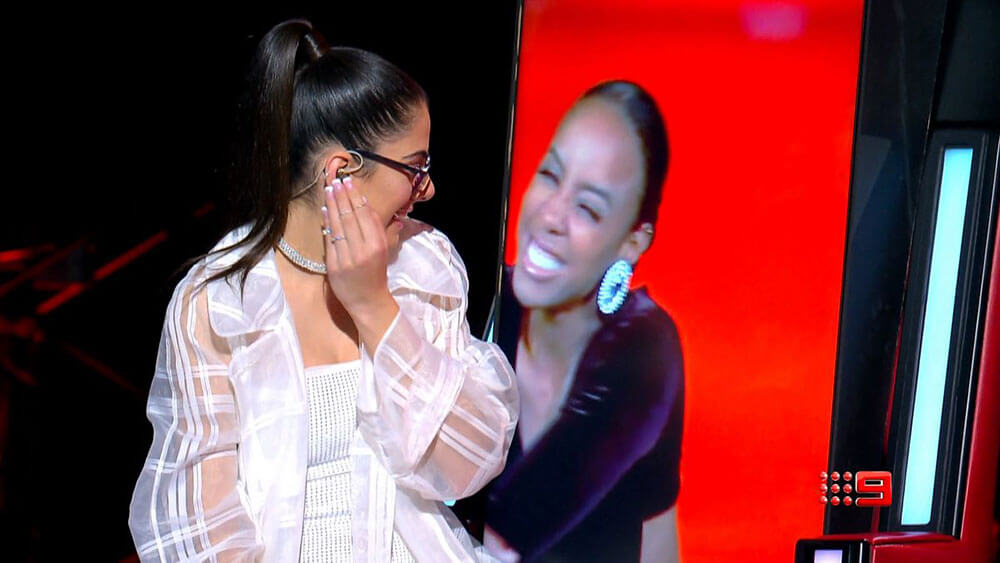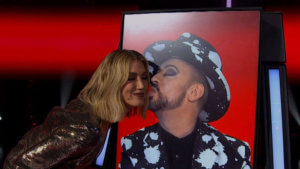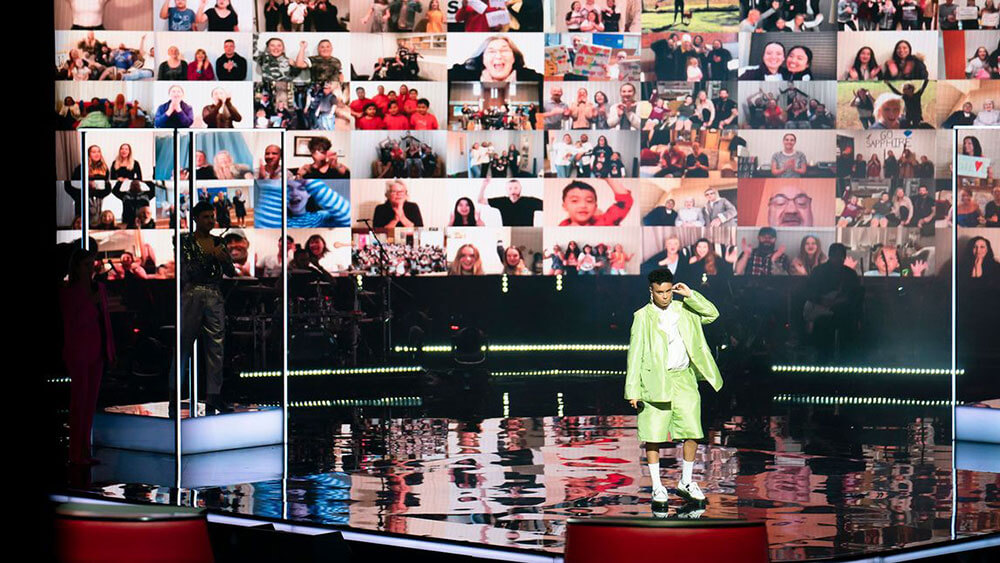
“The Voice” Australia coach Kelly Rowland gives artist Despina Savva a “virtual hug” from her home in Los Angeles during an episode of the reality series. (Photos courtesy Channel Nine Australia)
Facing COVID-19 travel restrictions that stranded two of its coaches abroad, “The Voice” Australia got creative — turning the music competition into a hybrid show using tweaks that organizers can use as cues for their own virtual events.
The first two rounds of the competition had been filmed in Sydney prior to stay-at-home orders that shut down production in March. At that time, coaches Boy George and Kelly Rowland returned to their homes in London and Los Angeles, respectively. When restrictions were eased and production resumed June 8, the two coaches could not return to Australia because a travel ban remained in effect.
That’s when the show’s supervising executive producer Leigh Aramberri and her team got creative. “Conversations changed daily based on how things were looking … it was certainly the greatest challenge I have faced in my time working on the show,” Aramberri told The Sydney Morning Herald.

Boy George, via satellite from London, gives fellow “The Voice” coach Delta Goodrem a kiss during an episode.
Rowland and George connected with their artists for mentoring sessions via video calls, and the show brought in various Australian music stars to help mentor their teams in person.
How to include the two in the live portion of episodes was a little trickier. “The Voice” worked with Rowland and George to get the proper equipment into their homes in order to beam them to the show via satellite hookup. On the set, large LCD televisions were placed on their sides in Rowland’s and George’s famous red chairs so the two appeared actually larger than life. They were able to watch and listen to performances, give their immediate feedback, and banter or argue with others, just as they always had. Fellow coaches Guy Sebastian and Delta Goodrem, as well as the artists and two hosts, all were on set in person.
The TVs made for funny, interactive moments during the episodes. At one point, Rowland invited one of her artists to “sit on my lap” for a cuddle of encouragement. Despina Savva sat in Rowland’s chair, in front of the TV, and Rowland gave her a “virtual hug.”
No physical embracing took place on set either, due to strict social-distancing rules the production put in place. Aramberri told Channel Nine network, which airs the reality series, that the production created safety requirements, including temperature checks, cleaning protocols for microphones and instruments, and personal hygiene best practices. A scaled-back crew filmed the remainder of the season and the number of the artists’ friends and family allowed on set was curtailed. On stage, the artists, dancers, and house band were separated by space and at times, set pieces.

“The Voice” artist Siala Robson (center) finishes a performance in front of a wall of virtual audience members. Backing vocalists and the band kept the required social distance.
Fans Create a Virtual Audience
The biggest change affecting the energy of the show was the required absence of a live studio audience. So the production created a virtual one, asking fans to video record themselves cheering and applauding their favorite artists. The virtual audience — all pre-recorded and not watching the actual performances live — appeared on TV screens behind the stage and at times behind the coaches.
While the “fake audience noise” did cause some backlash in Australia, NBC, the network that airs the U.S. version of “The Voice,” apparently liked the virtual audience. The production is asking fans to record themselves to be virtual audience members for the fall season of the show.
Like it did on “The Voice,” adding large TVs — or even large computer monitors — to the physical location of a hybrid event could bring remote participants into the middle of the action. And whether a tech-savvy event designer facilitates a live, beamed-in audience via screens or creates pre-recorded videos of participants asking questions or offering their thoughts, these options could give participants a more immersive experience.
Curt Wagner is an associate editor at Convene.
